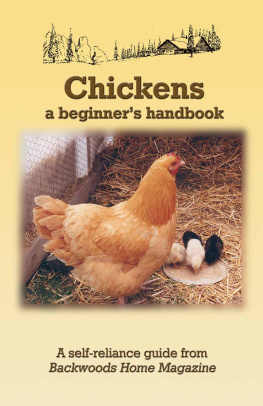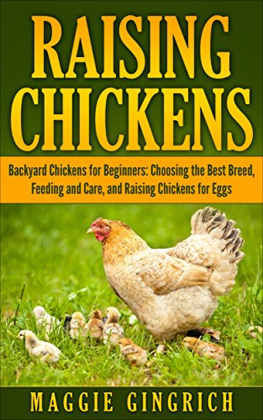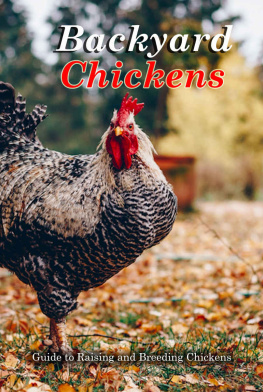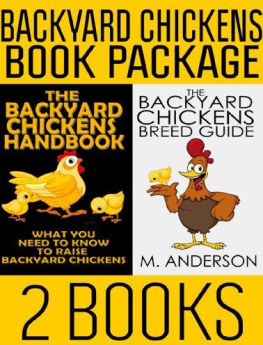Backwoods Home Magazine - Chickens: A beginners handbook
Here you can read online Backwoods Home Magazine - Chickens: A beginners handbook full text of the book (entire story) in english for free. Download pdf and epub, get meaning, cover and reviews about this ebook. year: 2013, publisher: Backwoods Home Magazine, genre: Home and family. Description of the work, (preface) as well as reviews are available. Best literature library LitArk.com created for fans of good reading and offers a wide selection of genres:
Romance novel
Science fiction
Adventure
Detective
Science
History
Home and family
Prose
Art
Politics
Computer
Non-fiction
Religion
Business
Children
Humor
Choose a favorite category and find really read worthwhile books. Enjoy immersion in the world of imagination, feel the emotions of the characters or learn something new for yourself, make an fascinating discovery.
- Book:Chickens: A beginners handbook
- Author:
- Publisher:Backwoods Home Magazine
- Genre:
- Year:2013
- Rating:3 / 5
- Favourites:Add to favourites
- Your mark:
- 60
- 1
- 2
- 3
- 4
- 5
Chickens: A beginners handbook: summary, description and annotation
We offer to read an annotation, description, summary or preface (depends on what the author of the book "Chickens: A beginners handbook" wrote himself). If you haven't found the necessary information about the book — write in the comments, we will try to find it.
Chickens: A beginners handbook — read online for free the complete book (whole text) full work
Below is the text of the book, divided by pages. System saving the place of the last page read, allows you to conveniently read the book "Chickens: A beginners handbook" online for free, without having to search again every time where you left off. Put a bookmark, and you can go to the page where you finished reading at any time.
Font size:
Interval:
Bookmark:
Table of Contents
Chickens
A beginner's handbook
Contributors
Dorothy Ainsworth, Susan BetzJitomir, Richard Blunt, Darlene Campbell, Jackie Clay, Katherine Dazazel, Ilene Duffy, Allen Easterly, Anita Evangelista, Dynah Geissal, Sylvia Gist, Roger W. Grim, Richard D. Kepple, Rich Kientopf, Edna Manning, Scott Matthews, Rodney Merrill, Amelia Porter, Charles Sanders, Clay Sawyer, John Silveira, Muriel Sutherland, Annie Tuttle, Delores Wilgenbusch, Sally Boulding
Edited by Jackie Clay, Lisa Nourse, Rhoda Denning

ISBN 0-9718445-8-5
Copyright 1989-2007
Backwoods Home Magazine
PO Box 712
Gold Beach, OR 97444

Back in 1944, E.B. White gave the following advice for keeping chickens:
l. Be tidy.
2. Be brave.
3. Walk, dont run.
4. Never carry any strange object.
5. Keep Rocks if you are a nervous man.
6. Keep Reds if you are a quiet one.
7. Do all your thinking and planning backwards.
8. Always count your chickens before they are hatched.
9. Tie your shoelaces in a double knot.
One of the most rewarding aspects of backwoods living is raising your own food from livestock. Chickens, with their meat and eggs, are a particularly sensible choice.
Susan BetzJitomir
One of the first types of livestock which many homesteaders undertake raising is the chicken. There is certainly no other species of animal more suited, nor more beneficial, to the homestead than the chicken. Meat, eggs, fertilizer, waste disposal, and pest control are among the qualities of the home flock.
Charles A. Sanders
Our motives for raising our own poultry are simple: we are concerned where our food supply comes from. The results of sloppy and confined commercial production of eggs and chickens is that antibiotic residues end up on our tables and in our bodies, and the chickens do not get a varied enough diet, robbing their meat and eggs of valuable nutrients.
Edna Manning
Chickens are the third animal most likely to be found on the farm. They are in the pheasant family and theyre descended from wild red jungle fowl of southeast Asia and eastern India. They werethe first bird man domesticated.
John Silveira
A small flock of chickens will provide you with plentiful eggs, as well as delicious meat if you so choose. I keep nine hens and a rooster, and the girls lay an average of 45 eggs a week. What I dont eat, I sell to my neighbors to pay for chicken feed. Generally, the flock is self-supporting.
Richard D. Kepple
as soon as I had my very own first homestead, shortly after graduating from high school, there were chickens on it. For 43 years, there have always been chickens on our various homesteads.
Jackie Clay
You can buy a dozen eggs at the supermarket for 99 cents, or you can go out to the chicken coop you built and fetch a warm egg out of the soft pine wood shavings in the nesting boxand thats priceless.
Dorothy Ainsworth
Why not keep a few laying hens? They are relatively inexpensive and easy to keep and each bird can reward you with a beautiful healthy egg every day or so.
Allen Easterly
A brief history of chickens
C hickens are often the first homestead livestock a person tries. And with good reason. They can be kept on a city lot, as well as a rural acreage. They are perhaps the most valuable addition to the self-reliant homestead. Not only do they provide meat and eggs, but also valuable fertilizer for the garden, insect and weed control, feathers, and a whole lot of entertainment to boot.
One cheerful rooster can even double as your rural alarm clock.
As they are small critters, anyone can handle them, whether its young children, great-grandma, a handicapped owner, or a timid ex-city dweller.
Huge or very small, theres a chicken for your needs and tastes (no pun intended). There are Black and White Giants that weigh as much as a small turkey, but there are also tiny Seabright bantams that will fit in the palm of your hand.
Housing and feed needs are simple, and care only takes minutes a day. But youll soon find that you spend much more time with your flock of chickens than thatjust because theyre so much fun.
A historical perspective
The domestic chicken has lived with humans for centuries. Chickens are in the pheasant family and theyre descended from wild red jungle fowl of Southeast Asia and eastern India. They were probably first domesticated about 6000 BC in India and is the first bird to be domesticated.
Among its characteristics that made it desirable as a domesticated bird is that the red jungle fowl is not a good flyeran attribute passed on to its domestic cousins. This made them a whole lot easier to keep.
Historians have found references to its domestic descendant in the art and literature of India, China, and Southeast Asia as early as 3000 BC. Egyptians were managing large flocks of chickens by the Second Dynasty (2890 to 2680 BC), but for some reason did not record much about their accomplishments in the breeding and keeping of chickens. Greek writings, however, describe how Egyptians designed and built clay incubators with the capacity to incubate and brood 10,000 to 15,000 chicks at a time. Incubators with greater capacity have only existed in this country and western Europe for about 80 years.
It was sometime before the sixth century BC that the Egyptians and the Persians introduced the wonders of domesticated chickens to the Greeks. The Persians shared their talent for breeding Malayan and Indian jungle fowl, which were used primarily for cockfighting, while the Egyptians taught the Greeks how to successfully develop and maintain breeds for the production of eggs and meat. For the next 200 years, chickens became an indispensable element in Greek life. At first they were used primarily in religious ceremonies, folk medicine, and the popular sport of cockfighting. But by the third century BC, breeding chickens for egg laying and meat production had become a priority in Greek civilization.
The Greeks passed their knowledge of the chicken on to the Romans. It was in Rome that the chicken truly reached its apotheosis. There, it became a sacred bird, often used as the central figure of various methods of divination, apothecary, and as a serious subject for philosophical inquiry. In Rome, fighting cocks were trained like gladiators. They were fed garlic before they fought in the belief that it would increase their courage and ferocity. The Romans also believed that garlic had the same effect on men. The writings of Roman naturalists and philosophers elevated the chicken to an exalted position in urban civilization. They skillfully molded it into a genuine object of scientific scrutiny and philosophical inquiry. No longer would the chicken be a taken-for-granted resident of the barnyard or cockpit.
Cockfighting
Today there are four types of fowl: fighting birds, egg-laying birds, meat-type birds, and ornamental birds. Its believed that one of the big reasons red jungle fowl were domesticated in the first place was because of their cockfighting abilities and that the first layers and meat-type birds we so much value today, and which form a large part of our economy, actually came from the selective breeding of fighting stock, as did the ornamental birds which are bred for show.
Cultural influence
The chicken has influenced our languages and cultures. From ancient times to the present, if two people look or act the same, they are said to be hatched from the same egg. The ancient Greeks compared poor writing to chicken scratches. Using the word chicken to describe a coward has been popular since Shakespeares time and the proverb, I would not have him count his chickens so soon before they hatched, was found in a collection of proverbs published in 1579.
Next pageFont size:
Interval:
Bookmark:
Similar books «Chickens: A beginners handbook»
Look at similar books to Chickens: A beginners handbook. We have selected literature similar in name and meaning in the hope of providing readers with more options to find new, interesting, not yet read works.
Discussion, reviews of the book Chickens: A beginners handbook and just readers' own opinions. Leave your comments, write what you think about the work, its meaning or the main characters. Specify what exactly you liked and what you didn't like, and why you think so.









